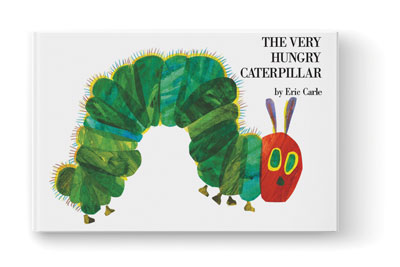4/1/2019
The Very Hungry Caterpillar
Jennifer Zurko

When my daughter Olivia was younger, she loved the books by Eric Carle. You’d probably recognize the fun illustrations, which Mr. Carle creates from a collage of hand-painted paper that he cuts out and layers to make really colorful images.
All of his books center around animals and nature. Olivia loved “Brown Bear, Brown Bear, What Do You See?” and the similar “Polar Bear, Polar Bear, What Do You Hear?” But her favorite was “The Very Hungry Caterpillar”.
If you don’t know the story about the Very Hungry Caterpillar, it goes like this: One Sunday morning, a caterpillar hatches from an egg and immediately starts looking for food because he’s very hungry, eating through everything he can find. Each day for six days straight, he eats more and more, until he’s a very fat, overstuffed caterpillar. The next day is Sunday again when he spins a cocoon around himself and sleeps for two weeks until one day, he emerges as a beautiful butterfly.
The genius of the book is that while the Very Hungry Caterpillar eats his way through life, the pages have holes in them to illustrate that the caterpillar had been there, eating his way through everything from strawberries and pears to chocolate cake and salami. I read that Eric Carle got the idea after he used a hole puncher in a stack of paper.
When Chris Truesdale (our Very Excellent Creative Director) and I were looking for images for this month’s cover story, I immediately thought of the Very Hungry Caterpillar. This particular caterpillar is the young stage of the Box Tree Moth (BTM), an extremely destructive pest of boxwood. When the adult BTMs lay their eggs on the boxwood, a multitude of very hungry caterpillars emerge to eat their fill until they make their cocoons. But instead of strawberries and salami, these guys will gorge themselves on the leaves and stems of the boxwood, pretty much killing the shrub.
For several years, Europe has been dealing with the BTM that hitchhiked from its native Asia, most likely on imports from China. It’s caused a lot of damage, with experts saying the boxwood forests that have the most defoliation was courtesy of the BTM.
This past fall, BTM was spotted for the first time in North America—a few areas in Toronto, Canada, actually—and many researchers and growers are nervous about whether it spread to other areas or, even worse, made its way down to the States. We won’t really know what we’re up against until the winter season is officially over (to see if it overwintered and/or spread), but in the meantime, entomologists, extension specialists and our friends at AmericanHort are being proactive and educating themselves about BTM. (As if boxwood didn’t have it bad enough with the Boxwood Blight we’ve been dealing with during the last seven years.)
And since this is our annual Pest Management Issue, we’ve got articles on other Very Hungry Pests, including Spotted Lanternfly (which was last year’s new pest), Rose Rosette Disease (which is caused by a Very Hungry Mite), root mealybugs, and thrips and aphids.
After reading this issue, I hope it doesn’t turn you into the Very Nervous Grower that needs a drink and/or an aspirin, but rather the Very Prepared Grower instead. GT